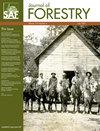在中欧森林中测试 treecbh:利用高分辨率航空激光扫描数据检测树冠基高的 R 软件包
IF 3.2
2区 农林科学
Q1 FORESTRY
引用次数: 0
摘要
有关树冠特征的准确信息对森林管理至关重要,但往往难以评估。本研究提出了一个创新框架,旨在利用高分辨率激光扫描数据进行树冠基高(CBH)检测,重点是森林中的单棵树木。该框架包括三个关键步骤(i) 使用 treesio 软件对输入的树木点云进行分割,以识别树干及其分支;(ii) 应用垂直截面 K-means 聚类对识别出的树木进行聚类,并确定去除低洼林下植被的海拔阈值;(iii) 在去除低洼林下植被后,采用新型二维核方法检测 CBH。二维核方法是利用离叶机载激光扫描(ALS)数据为阔叶林开发的,是 treecbh 工具的基础。该工具具有可视化 CBH 调整组件,可显示树木点云的二维剖面图,并提出 CBH 值供用户批准或调整。为了评估准确性,我们使用了德国和匈牙利五块林地的原位测量 CBH 数据,这些林地的树种组成各不相同。两块匈牙利地块的 ALS 数据是在落叶期采集的,三块德国地块的 ALS 数据是在开叶期采集的。在精度评估中还使用了单棵树木的落叶地面激光扫描数据。为了评估 treecbh 对点密度的敏感性,我们对地面激光扫描数据进行了随机点去角质敏感性分析。初步结果显示,离叶 ALS 地块的匹配率分别为 45% 和 60%,而使用该工具的可视化 CBH 调整功能后,匹配率分别大幅提高到 71% 和 77%。叶上 ALS 结果显示的匹配率介于 24% 和 33% 之间,而在视觉模式下,单个地面激光扫描树木的 CBH 检测准确率为 93%。据观察,当输入的 ALS 数据的最小点密度为 20 点/${text{m}}^2$ 时,treecbh 可有效运行,而当输入的 ALS 数据的最小点密度为 110 点/${text{m}}^2$ 时,treecbh 可达到最佳性能。这些发现表明,treecbh 对 ALS 数据质量、扫描季节(落叶期和落叶期)以及点密度非常敏感。通过利用该工具的可视化 CBH 调整功能,可以有效地减轻对落叶 ALS 数据的敏感性。本文章由计算机程序翻译,如有差异,请以英文原文为准。
Testing treecbh in Central European forests: an R package for crown base height detection using high-resolution aerial laser-scanned data
Accurate information regarding tree canopy characteristics is crucial for forest management, but it is often difficult to assess. This study presents an innovative framework designed for crown base height (CBH) detection using high-resolution laser-scanned data, with a specific focus on individual trees within forests. The framework comprises three key steps: (i) segmenting the input tree point cloud to identify the tree trunk and its branches using the treesio software; (ii) applying vertical cross-sectional K-means clustering to cluster the identified tree and to define the elevation threshold for removing low-lying understory vegetation; (iii) employing a novel 2D kernel method for detecting CBH after eliminating low-lying understory vegetation. The 2D kernel method, developed for broadleaf forests using leaf-off airborne laser scanning (ALS) data, underpins the treecbh tool. This tool features a visual CBH adjustment component that shows a 2D profile plot of the tree point cloud, and suggests a CBH value for user approval or adjustment. To evaluate accuracy, in situ measured CBH data from five forest plots in Germany and Hungary with varied species compositions were used. ALS data were collected during leaf-off conditions for the two Hungarian plots and during leaf-on conditions for the three German plots. Leaf-off terrestrial laser-scanned data from individual trees were also used in the accuracy assessment. A sensitivity analysis using random point decimation was conducted on the terrestrial laser-scanned data to assess treecbh’s sensitivity to point density. The initial results exhibited matching rates of 45% and 60% for leaf-off ALS plots, which significantly improved to 71% and 77%, respectively, when using the visual CBH adjustment feature of the tool. The leaf-on ALS results demonstrated matching rates between 24% and 33%, whereas the CBHs of individual terrestrial laser-scanned trees could be detected with 93% accuracy in visual mode. It was observed that treecbh operates effectively when the input ALS data have a minimum point density of 20 pts/${\text{m}}^2$, with its optimal performance achieved at 110 pts/${\text{m}}^2$. These findings indicated treecbh’s sensitivity to ALS data quality, scanning season (leaf-on and leaf-off), and point density. This sensitivity can be effectively mitigated in the case of leaf-off ALS data by utilizing the visual CBH adjustment feature of the tool.
求助全文
通过发布文献求助,成功后即可免费获取论文全文。
去求助
来源期刊

Forestry
农林科学-林学
CiteScore
6.70
自引率
7.10%
发文量
47
审稿时长
12-24 weeks
期刊介绍:
The journal is inclusive of all subjects, geographical zones and study locations, including trees in urban environments, plantations and natural forests. We welcome papers that consider economic, environmental and social factors and, in particular, studies that take an integrated approach to sustainable management. In considering suitability for publication, attention is given to the originality of contributions and their likely impact on policy and practice, as well as their contribution to the development of knowledge.
Special Issues - each year one edition of Forestry will be a Special Issue and will focus on one subject in detail; this will usually be by publication of the proceedings of an international meeting.
 求助内容:
求助内容: 应助结果提醒方式:
应助结果提醒方式:


